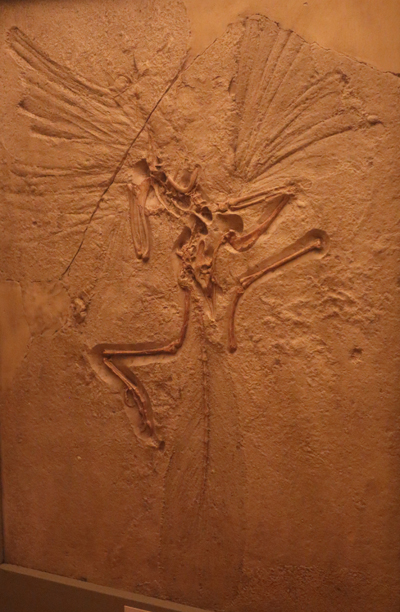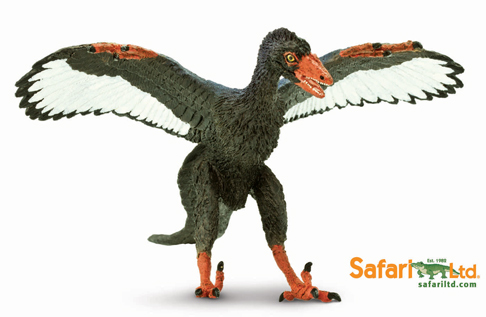Archaeopteryx – Back in the Black
The World’s Oldest Blackbird Takes Flight
A new Archaeopteryx study suggests that this early bird could achieve powered flight and provides an indication of this Jurassic creature’s colouration. Using an extremely powerful scanning electron microscope tell-tale melanosomes have been identified in a fossilised feather from the lithographic limestone deposits at Solnhofen. This new research published in the scientific journal “Nature Communications” not only provides information on the colouration of Archaeopteryx wings – black, but also adds weight to the theory that this primitive bird was an accomplished flier.
New Archaeopteryx Study
The international team of researchers from Brown University (Rhode Island, USA), Yale University, the University of Akron (Ohio, USA) and the Carl Zeiss laboratory (Germany) using advanced microscopy were able to identify the pigment structures found on the fossilised tip of a single feather. The feather was shed and ended up gently resting on the bottom of a shallow lagoon in what was to become southern Germany by a primitive bird approximately 150 million years ago.
The fine sediments being deposited in the still and anaerobic marine environment enabled the feather to be fossilised. The unique conditions at Solnhofen, allowed the exquisite preservation of this feather and this fossil specimen is just one of ten ascribed to the prehistoric creature known as Archaeopteryx lithographica.
Black Feathers
The researchers identified the colour of the crow-sized creature’s fossilised wing feather, determining it was black at the tip. The colour and the structures that supplied the pigment suggest that Archaeopteryx’s feathers were rigid and durable – just like a modern birds and this finding has important implications for the way scientists perceive Archaeopteryx. It adds weight to the hypothesis that this transitional creature between dinosaurs and birds was actually quite a strong flier.
Archaeopteryx is perhaps one of the most famous of all the creatures known from the fossil record. Identified and named just over 150 years ago, Archaeopteryx was about fifty centimetres long (most of the length being made up of its feathered covered tail). It had large eyes, teeth in its jaws and the forelimbs had three greatly extended fingers, each ending in a small, curved claw. The presence of feathers, so clearly seen in a number of specimens such as the “Berlin specimen” and the “London specimen”, helped scientists to interpret this creature as being a transitional fossil from the Dinosauria to birds – sometimes inaccurately called a “missing link”.
Picture credit: Everything Dinosaur
Commenting on the research work, lead author Ryan Carney, an evolutionary biologist at Brown University stated:
“If Archaeopteryx was flapping or gliding, the presence of melanosomes [pigment-producing parts of a cell] would have given the feathers additional structural support. This would have been advantageous during this early evolutionary stage of dinosaur flight.”
An Accomplished Aeronaut
Until recently, this single feather was regarded as the holotype for Archaeopteryx. A holotype is the specimen from which the original description of the organism is based. This is the fossil that is used to provide a scientific description of the organism, with which all other ascribed fossil material is compared to. Last year the ICZN (International Commission on Zoological Nomenclature) ruled that the so-called “London” specimen the fossil of Archaeopteryx purchased by Sir Richard Owen for what was to become the London Natural History Museum should be regarded as the holotype.
To read more about this development for Archaeopteryx: Natural History Museum Getting the Bird.
The Fossilised Feather Used in the Study (compared to that of a Modern Bird)
Picture credit: Brown University
If Archaeopteryx was one of the first birds, then what did it look like? This is a question that has intrigued scientists ever since the first fossils of this Jurassic “missing-link” were found back in the late 1850s. The single feather was analysed and found to be a covert feather, so named because these feathers cover the primary and secondary wing feathers birds use in flight. After two unsuccessful attempts to image the melanosomes, the group tried a more powerful type of scanning electron microscope at the Carl Zeiss laboratory, where the group located patches of hundreds of the indicative tube-shaped, pigment structures still encased and preserved in the fossilised feather.
The Electron Microscopy Revealing the Dense Pigment Structures
Image credit: Brown University
Graduate student, Ryan Carney added:
“The third time was the charm, and we finally found the keys to unlocking the feather’s original color, hidden in the rock for the past 150 million years.”
Melanosomes can provide scientists with an indication of the colouration of long extinct animals. Professor Mike Benton (University of Bristol) and his colleagues have pioneered this melanosome finding technique. Such structures had been found in fossils before, but they were interpreted as being bacteria, Professor Mike Benton and his team in conjunction with a number of other research institutes were able to identify pigment structures within the fossilised feathers of a dinosaur, providing the first evidence of the colours of a member of the Dinosauria.
To read more about this research: Melanosomes provide evidence of the Colour of Dinosaurs.
The team measured the length and width of the sausage-shaped melanosomes, roughly 1 micron long and 250 nanometers wide. To determine the melanosomes’ color, Akron researchers Matthew Shawkey and Liliana D’Alba statistically compared Archaeopteryx’s melanosomes with those found in 87 species of living birds, representing four classes: black, grey, brown, and a type found in penguins. Based on their findings the researchers were able to predict with 95% certainty that this part of the feathers on Archaeopteryx were black.
The scientific instruments and high powered microscopes at the Carl Zeiss laboratory gave the scientists an opportunity to examine the fossilised barbules preserved in the ancient feather. The barbules are tiny, rib-like appendages that overlap and interlock like a zip to give a feather rigidity and strength. The barbules and the alignment of melanosomes within them, are identical to those found in modern birds. If the feather structure of Archaeopteryx is very similar to modern neornithes (modern birds), this implies that Archaeopteryx may have been a capable flier.
A Model of Archaeopteryx with Black Feathers
Picture credit: Everything Dinosaur
The model shown above is the Wild Safari Prehistoric World Archaeopteryx model.
To see this range: Safari Ltd. Prehistoric Animal Models and Figures.
The black pigmentation and its significance is less obvious. The black colour of the Archaeopteryx wing feather may have served to regulate body temperature, act as camouflage as this bird flew about in the understorey of the surrounding woodland or perhaps it was used for display.
Carney concluded:
“We can’t say it’s proof that Archaeopteryx was a flier. But what we can say is that in modern bird feathers, these melanosomes provide additional strength and resistance to abrasion from flight, which is why wing feathers and their tips are the most likely areas to be pigmented. With Archaeopteryx, as with birds today, the melanosomes we found would have provided similar structural advantages, regardless of whether the pigmentation initially evolved for another purpose.”
What is intriguing from Everything Dinosaur’s perspective is that the single feather used in the study has no other fossil material related to it. The feather is attributed to Archaeopteryx as other fossils which include bones have been found in the same strata at the same location – but there is no definitive proof that the feather actually came from A. lithographica.
If there was one bird-like creature fluttering over the Solnhofen lagoon then there could have been others.





